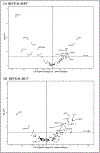Immunologic markers and risk of hepatocellular carcinoma in hepatitis B virus- and hepatitis C virus-infected individuals
- PMID: 34286851
- PMCID: PMC12332984
- DOI: 10.1111/apt.16524
Immunologic markers and risk of hepatocellular carcinoma in hepatitis B virus- and hepatitis C virus-infected individuals
Abstract
Background: Clinical and experimental studies suggest immunologic proteins contribute to hepatocellular carcinoma (HCC) development.
Aim: To evaluate circulating immunologic markers and HCC risk.
Methods: From a Taiwanese cohort of chronically hepatitis B virus (HBV)-infected individuals followed over time (REVEAL-HBV), we sampled 175 who developed HCC, 117 cirrhosis only, and 165 non-cirrhotic controls. From a similar Taiwanese cohort of chronically hepatitis C virus (HCV)-infected individuals (REVEAL-HCV), we included 94 individuals who developed HCC, 68 cirrhosis only and 100 non-cirrhotic controls. We compared pre-diagnostic plasma levels of 102 markers in HCC cases to non-cirrhotic and cirrhotic controls using polytomous logistic regression. A priori markers included insulin-like growth factor binding protein-3 (IGFBP-3), intercellular adhesion molecule 1 (ICAM-1) and interleukin 6 (IL-6). P-values for other markers were corrected for multiple testing (false discovery rate = 10%).
Results: In both REVEAL-HBV and REVEAL-HCV, increasing levels of ICAM-1 were associated with increased risk of HCC compared to non-cirrhotic controls (P-trend 0.02 and 0.001, respectively). In both REVEAL-HBV and REVEAL-HCV, two novel markers [C-X-C motif chemokine 11 (CXCL11) and hepatocyte growth factor (HGF)] were positively associated [strongest odds ratioquartile 4 versus 1 (OR) 4.55 for HGF in HCV], while two [complement factor H related 5 (CFHR5) and stem cell factor (SCF)] were negatively associated (strongest ORQ4vQ1 0.14 for SCF in HCV) with development of HCC compared to non-cirrhotic controls.
Conclusions: We confirmed the association for ICAM-1 and identified 4 additional proteins associated with HBV- and HCV-related HCC. These findings highlight the importance of immunologic processes in HBV- and HCV-related HCC.
© 2021 Mayo Foundation for Medical Education and Research. Alimentary Pharmacology & Therapeutics published by John Wiley & Sons Ltd.
Conflict of interest statement
Figures




Similar articles
-
Association between glycemic control and hepatocellular carcinoma risk in people with type 2 diabetes, stratified by chronic hepatitis B or C infection.Therap Adv Gastroenterol. 2025 Jul 31;18:17562848251356198. doi: 10.1177/17562848251356198. eCollection 2025. Therap Adv Gastroenterol. 2025. PMID: 40756178 Free PMC article.
-
Optimal surveillance intervals for hepatocellular carcinoma screening in cirrhotic patients with hepatitis C infection: a Taiwanese national cohort study.BMC Cancer. 2025 Jul 4;25(1):1141. doi: 10.1186/s12885-025-14551-9. BMC Cancer. 2025. PMID: 40615970 Free PMC article.
-
Prevalence and Risk Factors of Hepatocellular Carcinoma in Patients Co-infected With Hepatitis B Virus (HBV) and Hepatitis C Virus (HCV): A Cross-Sectional Retrospective Study.Cureus. 2025 Jun 14;17(6):e85985. doi: 10.7759/cureus.85985. eCollection 2025 Jun. Cureus. 2025. PMID: 40662001 Free PMC article.
-
Coinfection of hepatitis B and C viruses and risk of hepatocellular carcinoma: systematic review and meta-analysis.Int J Cancer. 2011 Jan 1;128(1):176-84. doi: 10.1002/ijc.25321. Int J Cancer. 2011. PMID: 20232388
-
Surveillance of cirrhosis for hepatocellular carcinoma: systematic review and economic analysis.Health Technol Assess. 2007 Sep;11(34):1-206. doi: 10.3310/hta11340. Health Technol Assess. 2007. PMID: 17767898
Cited by
-
Assessing Biomarkers in Viral Infection.Adv Exp Med Biol. 2023;1412:159-173. doi: 10.1007/978-3-031-28012-2_8. Adv Exp Med Biol. 2023. PMID: 37378766 Review.
-
Changes in Inflammatory Cytokines After Chronic Hepatitis C Treatment Among People Living With HIV.Open Forum Infect Dis. 2024 Jan 4;11(1):ofad623. doi: 10.1093/ofid/ofad623. eCollection 2024 Jan. Open Forum Infect Dis. 2024. PMID: 38192382 Free PMC article.
-
Pretreatment of UC-MSCs with IFN-α2 improves treatment of liver fibrosis by recruiting neutrophils.J Transl Med. 2023 Nov 18;21(1):832. doi: 10.1186/s12967-023-04732-0. J Transl Med. 2023. PMID: 37980535 Free PMC article.
-
Exploring the mechanism of JiGuCao capsule formula on treating hepatitis B virus infection via network pharmacology analysis and in vivo/vitro experiment verification.Front Pharmacol. 2023 Jun 8;14:1159094. doi: 10.3389/fphar.2023.1159094. eCollection 2023. Front Pharmacol. 2023. PMID: 37361218 Free PMC article.
-
The human factor H protein family - an update.Front Immunol. 2024 Feb 12;15:1135490. doi: 10.3389/fimmu.2024.1135490. eCollection 2024. Front Immunol. 2024. PMID: 38410512 Free PMC article. Review.
References
-
- Parkin DM. The global health burden of infection-associated cancers in the year 2002. Int J Cancer. 2006;118(12):3030–3044. - PubMed
-
- Schweitzer A, Horn J, Mikolajczyk RT, Krause G, Ott JJ. Estimations of worldwide prevalence of chronic hepatitis B virus infection: a systematic review of data published between 1965 and 2013. Lancet. 2015;386(10003):1546–1555. - PubMed
-
- Polaris Observatory HCVC. Global prevalence and genotype distribution of hepatitis C virus infection in 2015: a modelling study. Lancet Gastroenterol Hepatol. 2017;2(3):161–176. - PubMed
Publication types
MeSH terms
Substances
Grants and funding
LinkOut - more resources
Full Text Sources
Medical
Miscellaneous
